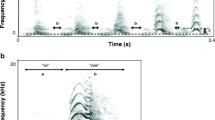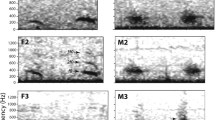Abstract
Males in many primate species give loud calls. Lifetime changes in loud calls may be due to either age or social changes. We examined loud call characteristics, loud call production and levels of fecal testosterone among 4 life-phases of male Thomas langurs (Presbytis thomasi): all-male band (AMB), early, middle, and late life-phase in mixed-sex groups. Discriminant analyses showed that a high percentage of loud calls could be assigned correctly to the proper life-phase. The most significant change in loud call characteristics is an increase in tonal units and duration from the AMB to the early life-phase, accompanied by a decrease in non-tonal units. Since adult AMB males have a similar age to that of early life-phase males, we suggest that social rather than age-related changes underlie the loud call differences between AMB males and early life-phase males. This could also be related to the increase in testosterone levels from the AMB to the early life-phase. In addition, we postulate that females may use loud call characteristics as a cue to choose between young and old males once they decided to leave their current male, and possibly also as a cue to decide to leave their current male as he enters his late life-phase.
Similar content being viewed by others
References
Ballintijn, M. R., and ten Cate, C. (1997). Vocal development and its interpretation in a non-songbird: The collared dove (Streptopelia decaocto). Behaviour 134: 595-621.
Butynski, T. M., Chapman, C. A., Chapman, L. J., and Weary, D. M. (1992). Use of male blue monkey “pyow” calls for long-term individual identification. Am. J. Primatol. 28: 183-189.
Cowlishaw, G. (1992). Song function in gibbons. Behaviour 121: 131-153.
Cowlishaw, G. (1996). Sexual selection and information content in gibbons song bouts. Ethology 102: 272-284.
Elowson, A. M., and Snowdon, C. T. (1994). Pygmy marmosets, Cebuella pygmaea, modify vocal structure in response to changed social environment. Anim. Behav. 47: 1267-1277.
Elowson, A. M., Snowdon, C. T., and Sweet, C. J. (1992). Ontogeny of trill and J-call vocalizations in the pygmy marmoset, Cebuella pygmaea. Anim. Behav. 43: 703-715.
Fischer, J., Hammerschmidt, K., Cheney, D. L., and Seyfarth, R. M. (2001). Acoustic features of female chacma baboons. Ethology 107: 33-54.
Gouzoules, H., and Gouzoules, S. (1989). Design features and developmental modification of pigtail macaque, Macaca nemestrina, agonistic screams. Anim. Behav. 37: 383-401.
Groothuis, T. G. G. (1993). A comparison between development of bird song and development of other displays. Neth. J. Zool. 43: 172-192.
Hammerschmidt, K., Newman, J. D., Champoux, M., and Suomi, S. J. (2000). Changes in rhesus macaque ‘coo’ vocalizations during early development. Ethology 106: 873-886.
Hauser, M. D. (1989). Ontogenetic changes in the comprehension and production of vervet (Cercopithecus aethiops) vocalizations. J. Comp. Psychol. 103: 149-158.
Herzog, M., and Hopf, S. (1983). Effects of species-specific vocalizations on the behaviour of surrogate-reared squirrel monkeys. Behaviour 86: 197-214.
Hochberg, Y. (1988). A sharper Bonferroni procedure for multiple tests of significance. Biometrika 75: 800-802.
Hohmann, G., and Vogl, L. (1991). Loud calls of male Niligiri langurs (Presbytis johnii): Age-, individual, and population specific differences. Int. J. Primatol. 12: 503-524.
Kraus, C., Heistermann, M., and Kappeler, P. M. (1999). Physiological suppression of sexual function of subordinate males: A subtle form of intrasexual competition among male sifakas (Propithecus verreauxii)? Physiol. Behav. 66: 855-861.
Lieblich, A. K., Symmes, D., Newman, S., and Shapiro, M. (1980). Development of the isolation peep in laboratory-bred squirrel monkeys. Anim. Behav. 28: 1-9.
Maggioncalda, A. N., Sapolsky, R. M., and Czekala, N. M. (1999). Reproductive hormone profiles in captive male orangutans: Implications for understanding develpomental arrest. Am. J. Phys. Anthropol. 109: 19-32.
Mitani, J. C., and Brandt, K. L. (1994). Social factors influence the acoustic variability in the long-distance calls of male chimpanzees. Ethology 96: 233-252.
Nieuwenhuijsen, K., Neef, K. J. de, and Werf ten Bosch, J. J. S. A. K. van der. (1987). Testosterone, testis size, seasonality, and behavior in group-living stumptail macaques (Macaca arctoides). Horm. Behav. 21: 153-169.
Nottebohm, F. (1999). The anatomy and timing of vocal learning in birds. In Hauser, M. D., and Konishi, M. (Eds.), The Design of Animal Communication, MIT press, Cambridge, MA, pp. 63-110.
Randall, J. A. (1989). Individual footdrumming signatures in banner-tailed kangaroo rats (Dipodomys spectabilis). Anim. Behav. 38: 620-630.
Rijksen, H. D. (1978). A Field Study on Sumatran Orangutans (Pongo pygmaeus abelii Lesson 1872), H. Veenman and Zonen, B.V, Wageningen.
Seyfarth, R. M., and Cheney, D. L. (1986). Vocal development in vervet monkeys. Anim. Behav. 34: 1640-1658.
Seyfarth, R. M., and Cheney, D. L. (1997). Some general features of vocal development in nonhuman primates. In Snowdon, C. T., and Hausberger, M. (Eds.), Social Influences on Vocal Development, Cambridge University Press, Cambridge, UK, pp. 249-273.
Seyfarth, R. M., and Cheney, D. L. (1999). Production, usage, and response in nonhuman primate vocal develoment. In Hauser, M. D., and Konishi, M. (Eds.), The Design of Animal Communication, MIT press, Cambridge, MA, pp. 392-417.
Snowdon, C. T., and Elowson, A. M. (1999). Pygmy marmosets modify call structure when paired. Ethology 105: 893-908.
Snowdon, C. T., Elowson, A. M., and Roush, R. S. (1997). Social influences on vocal development in new world primates. In Snowdon, C. T., and Hausberger, M. (Eds.), Social Influences on Vocal Development, Cambridge University Press, Cambridge, UK, pp. 235-248.
Steenbeek, R. (1999a). Female Choice and Male Coercion in Wild Thomas's Langurs, PhD Thesis, Utrecht University, The Netherlands.
Steenbeek, R. (1999b). Tenure related changes in wild Thomas's langurs. I: Between-group interactions. Behaviour 136: 595-625.
Steenbeek, R., and Assink, P. R. (1998). Individual differences long-distance calls of male wild Thomas langurs (Presbytis thomasi). Folia Primatol. 69: 77-80.
Steenbeek, R., Assink, P. R., and Wich, S. A. (1999). Tenure related changes in wild Thomas's langurs II: Loud calls. Behaviour 136: 627-650.
Steenbeek, R., Sterck, E. H. M., de Vries, H., and van Hooff, J. A. R. A. M. (2000). Costs and benefits of the one-male, age-graded and all-male phase in wild Thomas's langur groups. In Kappeler, P. M. (ed.), Primate Males, Cambridge University Press, Cambridge, UK, pp. 130-145.
Sterck, E. H. M. (1995). Females, Foods and Fights, PhD Thesis, Utrecht University, The Netherlands.
Sterck, E. H. M. (1997). Determinants of female dispersal in Thomas langurs. Am. J. Primatol. 42: 179-198.
Teixidor, P., and Byrne, R. W. (1999). The 'whinny' of spider monkeys: Individual recognition before situational meaning. Behaviour 136: 279-308.
Titze, I. R. (1994). Principles of voice production. Prentice Hall, Englewood Cliffs.
van., Schaik, C. P., Assink, P. R., and Salafsky, N. (1992). Territorial behavior in Southeast Asian langurs: Resource defense or mate defense. Am. J. Primatol. 26: 233-242.
van., Schaik, C. P., and Mirmanto, E. (1985). Spatial variation in the structure and litterfall of a Sumatran rainforest. Biotropica 17: 196-205.
Waser, P. M. (1977). Individual recognition, intragroup cohesion and intergroup spacing: Evidence from sound playback to forest monkeys. Behaviour 60: 28-74.
Wasser, S. K., Risler, L., and Steiner, R. A. (1988). Excreted steroids in primate feces over the menstrual cycle and pregnancy. Biol. Reprod. 39: 862-872.
Whitehead, J. M. (1987). Vocally mediated reciprocity between neighboring groups of mantled howling monkeys, Alouatta palliata palliata. Anim. Behav. 35: 1615-1627.
Wich, S. A. (2002). Thomas langurs (Presbytis thomasi) discriminate between calls of young solitary versus older group-living males: A factor in avoiding infanticide? PhD Thesis, Utrecht University, The Netherlands.
Wich, S. A., Assink, P. R., Becher, F., and Sterck, E. H. M. (2002a). Playbacks of loud calls to wild Thomas langurs (Primates; Presbytis thomasi): The effect of location. Behaviour 139: 65-78
Wich, S. A., Assink, P. R., Becher, F., and Sterck, E. H. M. (2002b). Playbacks of loud calls to wild Thomas langurs (Primates; Presbytis thomasi): The effect of familiarity. Behaviour 139: 79-87.
Wich, S. A., Koski, S., Vries, J. de, and van Schaik, C. P. (2003). Individual and contextual variation in Thomas langur male loud calls. Ethology 109: 1-13.
Wich, S. A., and Nunn, C. L. (2002). Do male “loud calls” function in mate defense? A comparative study of long-distance calls in primates. Behav. Ecol. Sociobiol. 54: 474-484.
Winter, P., Handley, P., Ploog, D., and Schott, D. (1973). Ontogeny of squirrel monkey calls under normal conditions and under acoustic isolation. Behaviour 47: 230-239.
Ziegler, T., Hodges, J. K., Winkler, P., and Heistermann, M. (2000). Hormonal correlates of reproductive seasonality in wild female Hanuman langurs (Presbytis entellus). Am. J. Primatol. 51: 119-134.
Author information
Authors and Affiliations
Corresponding author
Rights and permissions
About this article
Cite this article
Wich, S.A., van der Post, D.J., Heistermann, M. et al. Life-Phase Related Changes in Male Loud Call Characteristics and Testosterone Levels in Wild Thomas Langurs. International Journal of Primatology 24, 1251–1265 (2003). https://doi.org/10.1023/B:IJOP.0000005991.97232.2a
Issue Date:
DOI: https://doi.org/10.1023/B:IJOP.0000005991.97232.2a




